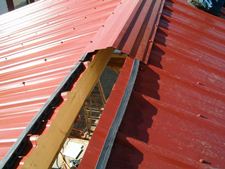How it is people end up owning steel roofing (or siding) when they do not have a structure to put it on has always been somewhat of a mystery to me.
Reader TIM in IRON RIVER writes:
“Hoping to build 40’x56′ post frame structure with 2′ overhang and 4/12 pitch using steel roofing I have on hand. That said it looks like I need roof lengths of 23′-1 1/4″ long to get that 2′ overhang. I have plenty of 20′-8″ and 2′ steel roofing and when combined with overlap I’ll be short (20′-8″ + 2′ minus 4″ overlap = 22′-4″) approximately a 9″ overhang. We do get plenty of rain here so the more overhang the better. For a 4/12 pitch how much overlap should I have for two adjoining roof pieces? Is there a vent gap at peak and if so how big of gap? Would 9″ overhang be sufficient for a rainy area to maintain building longevity? I guess I could go shorter on the 40′ width in order to use one single roof piece and to attain 2′ overhang. Your thoughts please.”
Mike the Pole Barn Guru responds:
If at all possible I try to avoid steel panels overlapping steel panels along their run.
Why?
Because all panels have been run through an identical set of dies, they are not designed with ‘outer’ panels having slightly larger ribs in order to accommodate a smooth lap transition. From experience, this overlap will attempt to “grow” on you as you go along your roof.
Most steel manufacturers recommend a minimum end lap of 12 inches. All overlaps should be made so as to center on a roof purlin. A 3/32″ x 1/2″ butyl endlap sealant should be applied on the bottom panel just below the centerline of the purlin where lap will occur. Due to the probability of panels not lying smoothly, sidelap sealants may also be needed.
Roof panels from each side should be held down from the peak of the roof by several inches (generally no greater than four with standard ridge caps) to allow for ventilation.
With all of this said, if it fits on your property, you should consider going to say 36′ x 60′ (or 72′), with 18″ overhangs to best utilize material you have and eliminate any overlapping splices. With 18″ overhangs on ends also, three foot width panels will lay out nicely without having to rip a panel when getting to building ends. Either of these building lengths will work out well for framing material usage with double trusses aligned with columns every 12 feet.







